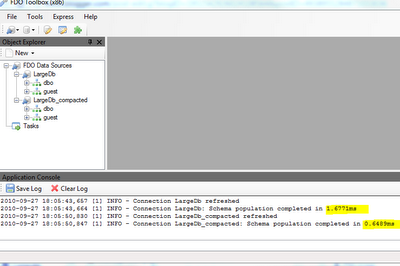The screenshot isn't big enough to show it, but there are 250 feature classes in this schema. Sometimes for security purposes, you don't exactly want to make all 250 feature classes visible to any FDO client application (eg. MapGuide). This is commonly known as reducing the attack surface.
With FDO XML configuration and the Unified Data Store editor, you can override the default logical schema (250 classes) with something that is more stripped down (like say: 10 classes)
To do this, we once again use the unified data store editor
Now select the feature classes you don't want visible and remove them (for ease of use, you can remove a feature class by hitting the Delete key as long as the class node is selected)
Now for the important bit: Do not apply the changes! Doing so will actually delete these feature classes from the underlying data store which we do not want! We just want to hide them.
Instead, we export this current state of the logical schema to an XML configuration file
Now if we make another connection with this XML configuration file
We see that the connection takes on the logical schema as defined in our XML configuration file.
Another benefit of a reduced attack surface is performance. Here's the schema walk of the 250 class connection (LargeDb) and the configured one (LargeDb_compacted):
Although SQL Server already implements FDO RFC23, and thus schema walking is already efficient, and the times in question (as you can see from the screenshot) are already well under 10ms, you can objectively see that having a stripped down logical schema via XML configuration does indeed improve performance, which makes sense (less classes = faster loading). Now a really good test case would've been the ArcSDE provider and the Utah SGID dataset, but unfortunately the ArcSDE provider does not support XML configuration :( so that's a case of "what if?".
Another wonderful use of FDO XML configuration brought to you by the Toolbox.








No comments:
Post a Comment